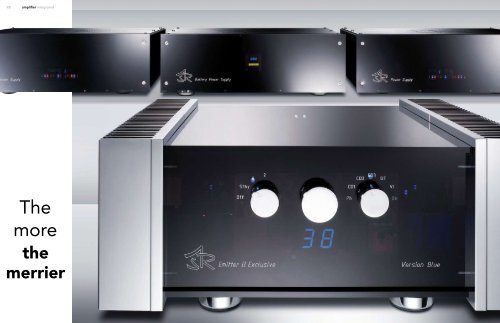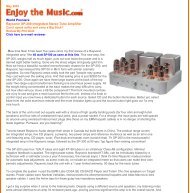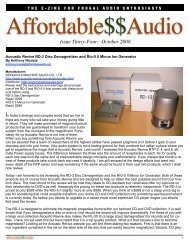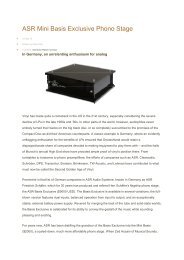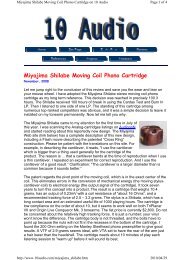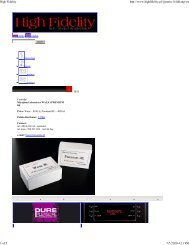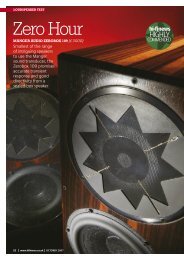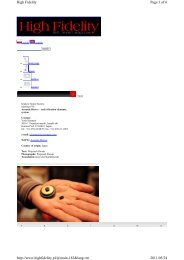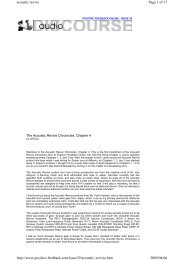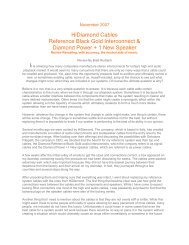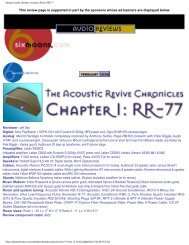ASR Emitter II Exclusive - Musical Sounds
ASR Emitter II Exclusive - Musical Sounds
ASR Emitter II Exclusive - Musical Sounds
- No tags were found...
Create successful ePaper yourself
Turn your PDF publications into a flip-book with our unique Google optimized e-Paper software.
98amplifier integratedThemorethemerrier
100amplifier integratedAll who appreciatemusic signalsensure they getgood amplification.Those wholove them transformthem in ahigh-end Germanstronghold into asurge of emotion.By Johannes MaierSackcloth and ashes,” muttered eventhe most hard-nosed testers as the<strong>Emitter</strong> <strong>II</strong> <strong>Exclusive</strong> was placed down onthe listening room table. Or to be moreprecise, the huge acrylic glass unit flankedby heat sinks with the actual amplifierand the solid brass control knobs onthe front. Split into three plate steel units,the power pack, which provides the supplyvia power lines as thick as your thumband weighty contacts, was on the floor– positioned at a distance of two metres,which any interfering magnetic fieldswould be unlikely to bridge.Made by <strong>ASR</strong> (Audio Systeme FriedrichSchäfer – the R stands for co-founderMichael Rompf, who has since movedon to motorbikes) of Herborn in the Germanstate of Hessen, the <strong>Emitter</strong> <strong>II</strong> <strong>Exclusive</strong>certainly looks stunning. However,it is not just its outer appearance thatmakes it so fascinating. Even the maincircuit board’s finely engraved, goldplatedconductor tracks show that it’s thecombination of might and delicacy thatgets you so deeply hooked. And althoughin its test in stereoplay way backin 1985 (thus over a quarter of a centuryago) the far simpler pre-predecessor, the<strong>Emitter</strong> I, succeeded in becoming thefirst integrated amplifier to be rated absolutelytop class, even the most addictedfan can scarcely judge how much experiencethe current <strong>ASR</strong> flagship has incorporatedwithin it today.Yet, Friedrich Schäfer, who constantlyexchanges ideas and experiences withhis customers, never let himself be ledby the audiophile scene’s know-alls ordogmatists. Whenever, for example, thepower and other connecting cables beingused, despite all efforts to prevent it,nevertheless have a certain influence onthe sound, he and his employees keptsearching for the optimum in conductorshape, profile and shielding, as well asfor the best balance between inductivityand capacity, until listening tests showedthat the electron slip could not be increasedany more.While it already took countless sessionsuntil the signal conductor gui- >In addition to theelectrolytic capacitorsin the mainspower units, theamp itself also hasmassive currentstorage capacity:4 x 4,700microfarads forthe drivers and48 x 10,000 forthe two poweramps.<strong>ASR</strong> <strong>Emitter</strong> <strong>II</strong>ExklusiveThe ‘On’ button is used toselect standby or operatingmodes 1 or 2. In mode 1 andwith the volume set relativelylow (users can define theirown limit) the <strong>Emitter</strong> poweramps run in energy-savingstyle at half operating voltage.In mode 2 the two highpowermains units constantlydeliver their full potential.
102amplifier integratedThe power ampmains unitsThe input rechargeablepower pack mainsunitThe mains voltage reaches the relaysvia a 10-amp fuse, provided forextreme emergencies. Dependingon whether the system is in energysavingor permanent high-voltagemode, the relays connect differentof the large transformers’ primarywindings. Groups of Schottky diodeswith a low switching peak provide asecondary rectifying function.Although the total of six Panasoniclead gel rechargeable batteriesare not able to provideanything other than clean current,<strong>ASR</strong> still gave each channeltwo iron-core inductors, six33,000-microfarad electrolyticcapacitors and WIMA film capacitorsfor further purification.When the system is not playingout audio, a mains transformerrecharges the batteries via adigital electronic regulator.de system assisted by shielded conductorsurfaces was cracked, the thicknessof the copper was also increased fromoriginally around 50 to 150 micrometres.And because it gave pleasure to bothears and eyes, a generous coating ofpure gold, costing over €40, was alsoadded. It is no wonder that <strong>ASR</strong> addslots of silver to its flow soldering bathand, where they are needed in criticalplaces (for example, for connecting theCD2 and CD3 balanced inputs), the onlywires that come into question are puresilver ones with Teflon insulation.However, it is still a just a case of minortweaks, as essentially the rarely satedyearning of amplifier stages for multiple,abundant and completely pure provisionof power drove up the costs. Thus thetwo stereo channels and the power ampson both sides, the drivers and the inputIC each get their feed served from theirown big kitchen.In the case of the latter, it is not justenough to provide princely nourishmentand theoretically the available powercould even vaporise the unit in a flash.Nevertheless, it was not until using arechargeable power pack, ergo the mostpulse-rich of all sources, that Schäfer undCo. began to explore the best possiblein auditory spaciousness and lack of noise.For the <strong>Emitter</strong> <strong>II</strong> <strong>Exclusive</strong> they thereforebuilt a production version with atotal of six Panasonic lead gel rechargeablebatteries, plenty of additional filteringelectrolytic capacitors and grand chargingelectronics.This gives the remaining amplificationcircuits far from any reason to complain.In one steel cabinet each for right andleft channels two 700-watt transformersshare the responsibility for the positiveand negative voltages. After rectificationusing fast-switching Schottky diodes (inorder to increase the current propensity,<strong>ASR</strong> always jump straight to switching acouple in parallel), plus purging and stockingup using eight 33,000-microfaradand four 4,700-microfarad electrolyticA connectivity option (centre) keeps main DC offsets away from the <strong>Emitter</strong>.capacitors, what then comes out is +/-90volts for the drivers and +/-80 volts forthe power amps.Yet even more than the quantity, it isthe quality of the components that thehigh ender admires. The transformercores, for example, are made of expensivepanels procured from Switzerlandand cut in a design named after the physicistbrothers Bernhard and Karl Philbert.In contrast to run-of-the-mill iron statorswith EI lamination, with the Philbert coresa relatively small gap is closed using awedge. They thus offer rounder magneticflow and improved power storagecapacity (especially compared to ringcores).Other manufacturers would, incidentally,never consider using the terriblyexpensive blue Vishay BComponentselectrolytic capacitors in a product forthe consumer market. Schäfer, nevertheless,uses these long-lasting and fastpulsedelectric energy stores unapologeticallyby the dozen.Thus the technician can turn – with noworries at all about the power supply – tothe actual emitter switching. It beginswith five high-level phono inputs and twoadditional balanced ones, the si- ><strong>Emitter</strong> familyStill young at heartIt was as long as 25 years ago thatthe <strong>ASR</strong> I, launched at a price of3,000 marks and with two mainstransformers in a separate unit,picked up its first test victory. Significantlyit was in the same edition(August 1985), in which stereoplayfirst described the distortion theoryin an article entitled ‘Dem Klang aufder Spur’ (On the trail of sound).The <strong>ASR</strong> fitted wonderfully into thepicture of regular and quickly declining‘warm’ harmonics. The <strong>Emitter</strong><strong>II</strong> <strong>Exclusive</strong> now delivers distortioncharacteristics of unbeatable quality.And this is true of the entire family,i.e. also of the current <strong>Emitter</strong> Ifrom €5,800 and the ‘basic’ <strong>Emitter</strong><strong>II</strong> from €8,800. It is not possiblegive precise prices, as <strong>ASR</strong> makesits amplifiers – in terms of numberand type of inputs and outputs, forinstance – on an individual basis tocustomer specifications.Well loaded up even then: the1985 <strong>ASR</strong> <strong>Emitter</strong> I. Rectificationand electrolytic capacitorcurrent storage still took placeinside the amp itself.
104amplifier integratedTypical Friedrich SchäferIt was never my intentionto build theworld’s best integratedamplifiers. Mythinking is rather thatthere must be otherfish in the sea.shion – via their plus and minus supplycurrents. Because the <strong>Emitter</strong> wants to remainsnappy and three-stage, the driversalready face some tricky challenges. Especiallyat high levels, where they have totransfer the great capacity of the outputFETs. After all, on each side of the channeland on each push-pull side no less thanfive thick output transistors register demandsfor voltage. In order to avoid anyimbalance, here too the previous workinggnals of which are also transformed tounipolar as soon as they are received.Then comes a relay bank for source selectionand another one, which with 16processor-controlled contacts per channeldetermines the volume setting.Through various resistance combinationsconducting parts of the input voltageaway to earth, the emitter offers a totalof 71 decibel levels.After the unavoidable attenuators, thesignals glide along to the Burr Brown OPA551 IC amps. These shine not only with theaforementioned luxury power supply, butalso with field effect transistors in their inputsthat are extremely low-noise and requirepractically no control current. Moreover,their outputs do not prime the reactiveload of any subsequent semi-conductor,but merely heat up a simple resistance. TheICs are thus spared any particularly greatstress with the risk of distortion.The following driver stages equippedwith already taut individual field effect transistorsare driven by the OPA 551s almostin passing and yet in highly symmetric faelementalso releases a part of the powerto frequency-neutral resistances.After this excursion into the nitty-gritty,the <strong>Emitter</strong> admirer can now enjoy someother details. For example, the fact thatthe armada of in total 20 output transistorssits not right on top of the aluminium coolers,but on a square of solid brass, whichcan distribute the discharged heat better.Adorning the OPA 551 (and a DC standardIC next to it) is a brightly polished brasscube, designed to stem not only surges ofheat but also mechanical resonances. Forfans with dirty mains power <strong>ASR</strong> very prudentlyship the <strong>Emitter</strong> <strong>II</strong> <strong>Exclusive</strong> with aspecial mains cable. In a small box at thehalfway point there are anti-parallel diodesthat provide protection from DC elements,transformer over-saturation and humming.In the listening room the testers thenhad their breath completely taken away.Even from relatively normal-sized speakersthe <strong>ASR</strong> forced out practically monumentalbass tones. Or to put it better: it createdfor them their own seemingly endlessspace. For example, for Mark Egan’s fretlessbass escapades on the ‘Truth Be Told’ CD.Where even the better amplifiers only hintat their vigorous, rousing power, the <strong>Emitter</strong>conveyed the low-frequency elementswith noticeable weight and so three-dimensionallythat you could almost put your armsaround them. A bass line would thus plummetinto the deep to develop ever moreboldness, stringency, darkness and acceleration.And as Mitch Forman worked thebass-drum pedals ever more frantically andraced across the cymbals in order to callthe freed, bottomless bass monsters toorder, they began to overflow with defiantjoy.As soon as Bill Evans began his sax solo,however, they took on a more well-behaved,more supporting role. And then the<strong>Emitter</strong> invited the listener to a wild, adventurouschase in a no less magnificentlybroad mid-range paradise. Just a few musicalexamples led to the clear recognitionthat this <strong>Emitter</strong> does not bring music intothe listening room, like other amplifiers.Rather it draws its fans out of there in orderIf customers wish, they can alsoget the <strong>Emitter</strong> not just withclean, rounded wings, but withchrome-plated ones as well.to place them into a lavishly opulent andcolourful life of music.While with rock and pop the <strong>Emitter</strong>proved to be the clear number 1 amongthe integrated amplifiers of this galaxy, itdid show some excessive exuberance withvery sensitive vocals. Ulita Knaus soundedlovely and feminine, backed by music playedwith lightness and finesse. Then, however,the singer seemed to indicate: “Dear<strong>Emitter</strong> <strong>II</strong> <strong>Exclusive</strong>, you’re almost impinginga bit too much on my own space. Andwhile I am standing with both feet on theground, my legs are fairly slim.” The <strong>Emitter</strong>saw that as no reason to feel embarrassed– after all, it enjoys strong bodies andtrim legs.>The AuthorJohannesMaierJohannes Maier began his life as atester in the early ‘80s under hi-figodfather Karl Breh at HiFi-Stereophonie.He developed test proceduresfor VHF tuners and amplifiers andlater paved the way for SAT-DVB radio.In 1985, after detailed analysis ofdozens of amps, he defined the nowglobally recognised distortion theory.Appliance<strong>Emitter</strong> <strong>II</strong> <strong>Exclusive</strong>List price: c. €15,000Guarantee period: 3 yearsWxHxD: 57 x 23 x 47 cm (mainappliance)Weight: 47 kg (plus 26 + 2 x 32 kg)Finish: Acrylic glass with anodised orchrome-plated side heat sinksTest unit’s connections: 2 XLR and 5RCA line inputs, 1 direct input,2 tape and 1 subwoofer outputMeasurements: Measurements: Measurements:Frequency response Distortion characteristicsPerformance cubeAUDIOphile ProfileThe strengthsMaximum dynamicsFull, firm bassLots of detail at every levelStrict neutrality<strong>ASR</strong>ContactSales and distribution:<strong>ASR</strong> Audio SystemeFriedrich Schäfer35745 HerbornGermanyHohe Straße 700, Gebäude 5 ATel.: 0049 (0)2772 / 649 880Internet: www.asraudio.deExtremely wide bandwidth frequencyresponse up to over 100kHz.From the fact that even with alow-resistance charge it doesn’t flagat high levels it can be concludedthat the <strong>Emitter</strong> <strong>II</strong> gets by on a lowoverall negative feedback factor.According to the manufacturer thelevel set was 20dB – by transistorstandards a relatively low one.The distortion characteristics, measuredstarting on the left with lowleveloutput all the way to full conduction(and then back again), looked asthough they were straight out of thecopybook. There was certainly still afavourable graduation from the firstharmonic to the second and then tothe third and fourth. This indicates amusical setting.With record levels of amplitudeand height the performance cubeshows that the <strong>Emitter</strong> <strong>II</strong> <strong>Exclusive</strong>can supply more than enough powerboth to speakers that want to seelots of voltage and to those lookingfor huge amounts of current. Phaseshifts leave it totally unimpressed.Gripping emotionalityGreat feel-good factorBreezily effortless nuancesGreat flexibilityModest footprint


